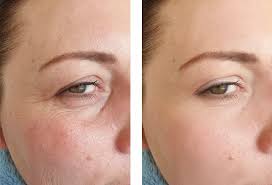
How Long Does Retinol Take To Get Rid Of Wrinkles?
How long do retinoids take to improve wrinkles? Retinoids can take months to see improvement of wrinkles, but how fast you see results of the benefits of retinol depends upon what strength of retinoid you use. Retinol takes the longest to work on wrinkles but it is the only retinoid that works well that you can get without a prescription. To get rid of wrinkles, you need to combine retinol or other retinoids in a complete antiaging skin care routine. You can combine retinoids with other antiaging ingredients to make them work faster.
Shop by your Baumann Skin Type to find the best retinoid for your skin type.
Take the Quiz
Before we discuss how long it takes to see results from retinol, let’s discuss nomenclature.
Retinol is a type of retinoid.1 There are prescription and cosmetic retinoids:
Retinol is fa cosmetic retinoid found in cosmetic products
Adapalene is in cosmetic products, over-the-counter products for acne, and prescription products
Tretinoin is prescription ad is FDA approved for aging and acne
Tazarotene is prescription only and is FDA approved for aging and acne
Trifarotene in prescription products for acne.
The only retinoids FDA approved to treat wrinkles are tretinoin and tazarotene. However, studies have shown that retinol is effective on wrinkles.2
This blog will review the peer-reviewed evidence-based data on using retinol and retinoids for wrinkles.
How does retinol work to get rid of wrinkles?
How Soon Can Changes In Skin From Retinoids Be Seen With A Microscope?
In a study3 comparing tretinoin 0.1% and retinol 0.1%, both retinoids showed skin improvement under the microscope at 4 weeks. However, it usually takes at least 12- 24 weeks to see skin changes without a microscope.
How Fast Can Retinol Improve Wrinkles?
Studies have shown that retinol improves wrinkles. Retinol 0.1% was shown to improve crow’s feet lines by 44% at 52 weeks (one year).4 How fast wrinkles improve depends on the potency, frequency and amount of retinoid used. The other antiaging ingredients and products in your skin care routine will also affect how fast retinol works.
You do not want to start a strong retinoid too quickly because it can lead to retinoid side effects. Remember that prescription retinoids are stronger than retinol so you will see results faster with prescription retinoids. However, we advise you to first begin a low-strength retinol and work your way up slowly to a stronger retinol and then convert over to a prescription strength retinoid. Click here to see how to use retinoids.
Or even better- shop by your skin type and we will tell you exactly which retinol brands to choose from.
Take the Quiz
Which Retinoid Cream Improves Wrinkles The Fastest?
In 2001, a study (5) compared these prescription retinoids:
Tazarotene 0.01%
Tazarotene0.025%
Tazarotene 0.05%
Tazarotene 0.1%
Tretinoin 0.05% cream
These prescription retinoids were applied every night for 24 weeks.
All of the percentages of tazarotene and the 0.05% tretinoin improved fine wrinkles and evened skin tone.
Tazarotene 0.1% worked the best at 8, 12, and 20 weeks but had a higher rate of side effects.
However, by 24 weeks, tretinoin 0.05% and tazarotene 0.1% had similar results.
This study shows that wrinkles improve the fastest with tazarotene 0.1% as compared to tretinoin 0.05% and lower doses of tazarotene.
Studies showing how fast prescription retinoids get rid of wrinkles:
How Fast Does Tretinoin Improve Wrinkles?
Most people who use tretinoin see improvement of wrinkles by 24 weeks.6 A higher percent of tretinoin (0.1%) has faster improvement of wrinkles as compared to a tretinoin strength of 0.05%.
Higher-strength tretinoin improves wrinkles faster than low doses do, however, with time, they both improve wrinkles the same.
A 1995 study compared wrinkle improvement placebo cream vs tretinoin 0.025% cream vs tretinoin 0.1%.7 As expected, the 0.025% cream was associated with fewer side effects than the 0.1% tretinoin. At 48 weeks, the improvement of wrinkles was the same (there was no statistical difference) for both doses of tretinoin- showing that lower strength retinoids will have the same improvement as the higher strength ones with time.
Do Stronger Retinoids Improve Wrinkles Faster?
Higher percentages of retinoids improve wrinkles faster, so if you want to get rid of wrinkles quickly, a stronger retinoid is the way to go but be prepared to have more side effects. Many studies have shown that weaker retinoids take longer to see results, but have fewer side effects.8
One study of tretinoin emollient cream for 48 weeks compared two groups: the first group used tretinoin 0.05% and the other group used tretinoin 0.01%. At 24 weeks, more improvement was seen in the 0.05% group as expected because this was a more potent form of retinoid. The 0.01% group showed less improvement at 24 weeks but continued to improve from weeks 24- 48. By 48 weeks, the lower dose group still did not achieve the levels of improvement observed with the stronger 0.05% formulation. These results demonstrate that higher doses yield a faster and better response at 48 weeks, but lower doses do cause improvement in wrinkles and skin appearance.
How Fast Does Tazarotene Improve Wrinkles?
Studies have shown that tazarotene 0.1% is the most effective antiaging retinoid. It was approved by the FDA in 19979 to improve the appearance of fine facial wrinkles and uneven skin tone. Results may be seen as early as 8 weeks.10 One study of tazarotene 0.1% gel ( compared to placebo) used on the arms showed improvement of wrinkles and skin texture at 12 weeks.11 A summary of research trials using tazarotene for wrinkles can be found in this reference.12
In summary- the higher a retinoid percentage is- the faster wrinkles and fine lines will go away but more side effects will be seen. Retinoid side effects can lead to inflammation and pigmentation. Inflammation is a cause of skin aging and an uneven skin tone is undesirable. For this reason- we recommend starting with a low strength retinoid and slowly working your way up to the strongest retinoid that you can tolerate without getting skin inflammation.
The best way to find the retinoid that will work fastest for you and learn what products to combine it with in your skin care routine to speed results is to shop by your Baumann Skin Type.


